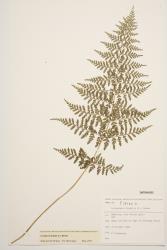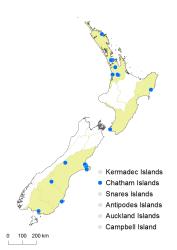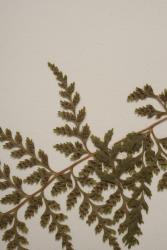- ≡ Polypodium fragile L., Sp. Pl. 1091 (1753) – as Polypodium filix-fragile
- = Cystopteris laciniatus Colenso, Trans. & Proc. New Zealand Inst. 31: 265 (1899)
Rhizomes short-creeping, up to 40 mm long (in herbarium specimens), 1.5–2.5 mm in diameter, with stipes arising 5–10 mm apart; bearing scales. Rhizome scales narrowly ovate, 2.0–3.5 mm long, 0.4–0.8 mm wide, golden brown. Fronds 110–475 mm long. Stipes 25–200 mm long, pale brown or yellow-brown; bearing scattered narrowly ovate, pale brown scales with filiform apices, up to 4 mm long, 0.5 mm wide. Rachises pale brown, becoming green distally, winged distally, sulcate, bearing scattered hair-like scales up to 1.5 mm long. Laminae 2–3-pinnate, ovate to narrowly ovate, tapering to a pinnatifid apex, 75–280 mm long, 26–175 mm wide, yellow-green on both surfaces, herbaceous, glabrous. Primary pinnae in 10–20 pairs, narrowly spaced or slightly overlapping distally, winged throughout, ovate; the longest at or below the middle, short-stalked, 16–95 mm long, 9–50 mm wide, apices acute to acuminate. Secondary pinnae winged throughout, gradually decreasing in length along each primary pinna to the distal end; the longest secondary pinnae ovate, 6–30 mm long, 4–13 mm wide, apices acute or acuminate, bases shortly stalked, margins partly or completely divided to the midrib; the distal secondary pinnae narrowly ovate to oblong, apices acute, bases adnate. Tertiary segments 3–8 mm long, 1–4 mm wide, margins incised. Sori round, on veins; indusia ovate to broader than long, 0.6–1 mm long.
Cystopteris fragilis is a naturalised plant confined largely to lowland areas, usually near urban centres. It is distinguished morphologically from the indigenous C. tasmanica by its generally larger and more divided laminae (2–3-pinnate cf. 1–2-pinnate), by its longer and wider primary pinnae (16–95 mm long, 9–50 mm wide cf. 6–42 mm long, 4–24 mm wide), and by the apices of its primary and secondary pinnae, which are acute to acuminate rather than obtuse or rounded.
North Island: Northland, Auckland, Gisborne, Southern North Island.
South Island: Canterbury, Otago, Southland.
Chatham Islands.
Altitudinal range: 0–240 m.
A widespread northern temperate species first recorded by Colenso (1899) as C. laciniatus. It is naturalised in Auckland city, around Hamilton and parts of the Waikato, in Wellington and Christchurch, on Banks Peninsula, and in Dunedin, Invercargill, and on the Chatham Islands. It occurs mostly in lowland areas but reaches 240 m on Banks Peninsula, and probably higher in inland Canterbury.
Cystopteris fragilis occurs most frequently in or near urban areas, where it grows along shaded streams and road banks, and in roadside ditches, often under Salix species or broadleaved forest.
Colenso (1899, p. 265). Voucher AK 135924, 1898. A specimen in the Armstrong Herbarium (CHR 633386) labelled "Cystopteris fragilis, naturalised, Christchurch, JBA" probably represents an even earlier record, but is undated.
Cystopteris laciniatus was described by Colenso (1899) from a plant collected in North Canterbury by T. Keir in 1898. The only extant specimen (AK 135924) consists of two fronds taken by Colenso from a living plant in cultivation, originally from Canterbury, and labelled "Cystopteris laciniatus sp. nov." in his own hand-writing. There are no specimens at K or WELT, and in the absence of other authentic material, the AK specimen is assumed to be the holotype. The specimens are clearly identifiable as the naturalised C. fragilis.






